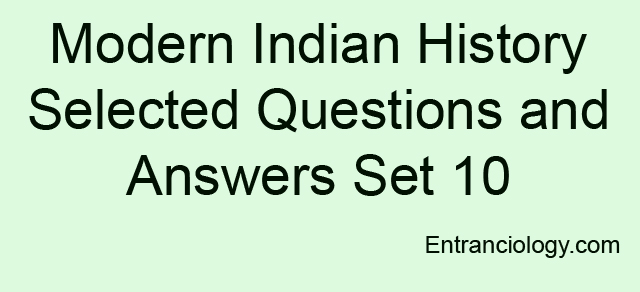
Q.1:- The Prime Minister of England at the time of Quit India Movement was ?
- Chamberlain
- Churchill
- Clement Attlee
- Mac Donald
Q.2:- Why did people gather to demonstrate at Jallianwala Bagh ?
- To protest against the arrest of Gandhiji and Lajpat Rai
- To protest against the arrest of Kitchlu and Satyapal
- To offer prayers on the Baisakhi Day
- To protest against the arbitrarily of inhuman acts of the Punjab Government
Q.3:- Quit India Movement began on ?
- 9th August, 1942
- 10th August, 1942
- 15th August, 1942
- 16th August, 1942
Q.4:- The Chairman of Joint Parliamentary Committee of the 1935 Bill that led to the framing of the Government of India Act of 1935 was ?
- Lord Linlithgow
- James Mac Donald
- Winston Churchill
- Clement Attlee
Q.5:- Which of the following Acts was described by Jawahar Lal Nehru as ‘New Charter of Slavery’ ?
- Government of India Acts, 1919
- Government of India Act, 1935
- Regulating Act of 1773
- Pitt’s India Act of 1784
Q.6:- The name of the famous person of India who returned the knighthood conferred on him by the British Government as a token of protest against the atrocities in Punjab in 1919 was ?
- Tej Bahadur Sapru
- Ashutosh Mukherjee
- Rabindra Nath Tagore
- Syed Ahmed Khan
Q.7:- In which one of the following provinces was a congress ministry not formed under the Act of 1935 ?
- Bihar
- Madras
- Orissa
- Punjab
Q.8:- The Balkan Plan for fragmentation of India was the brainchild of ?
- Churchill
- A. Jinnah
- Lord Mountbatten
- P. Menon
Q.9:- At which Congress Session was the Congress Working Committee authorized the launch at programme of Civil Disobedience ?
- Bombay
- Lahore
- Lucknow
- Tripuri
Q.10:- Who is known as ‘Nightingale of India’ ?
- Vijaya Laxmi Pandit
- Lata Mangeshkar
- Sarojini Naidu
- Noor Jahan
Q.11:- The Universities of Calcutta, Madras and Bombay were founded in the year ?
- 1845
- 1854
- 1857
- 1861
Q.12:- Who from the following leaders was not assassinated ?
- Mahatma Gandhi
- Liaqat Ali Khan
- Muhammad Ali Jinnah
- Lord Mountbatten
Q.13:- At which place of Bihar, Gandhiji started Satyagraha movement for the first time in India ?
- Patna
- Gaya
- Madhubani
- Champaran
Q.14:- The Poona Pact aimed ?
- At Hindu – Muslim Unity
- To represent to lower cast
- At privileges to princes
- To review the Diarchy
Q.15:- Name one leader of the Home Rule Movement ?
- Annie Besant
- Aurobindo Ghosh
- Surendra Nath Bannerjee
- Bipin Chandra Pal
Q.16:- Who was the founder of All India Muslim League ?
- Syed Ahmed Khan
- Mohammad Iqbal
- Agha Khan
- Nawab Salimullah Khan
Q.17:- Provincial Autonomy was one of the important features of the Act of ?
- 1935
- 1919
- 1909
- 1858
Q.18:- The Rani Jhansi Regiment, the women’s regiment of Azad Hind Fauj, was under whose command ?
- Usha Mehta
- Anne Marcarence
- Annie Besant
- Lakshmi Sehgal
Q.19:- Jai Prakash Narayan belonged to which Party ?
- Congress
- Kisan Sabha
- Socialist
- Raivadi
Q.20:- Sabarmati Ashram, established by Mahatma Gandhi during the course of India’s independence movement, is located on the outskirt of ?
- Gandhinagar
- Ahmedabad
- Rajkot
- Wardha
Q.21:- Who gave the slogan ‘Jai Hind’ ?
- K. Gandhi
- L. Nehru
- C. Bose
- G. Tilak
Q.22:- The Muslim League first gave the call for a separate state of Pakistan in ?
- 1939
- 1940
- 1941
- 1942
Q.23:- The Indian National Army (INA) came into existence in 1943 in ?
- Japan
- Then Burma
- Singapore
- Then Malaya
Q.24:- Sarvodaya stands for ?
- Total Revolution
- Non-Cooperation
- Upliftment of all
- Non-Violence
Q.25:- With which of the following newspapers was Jawahar Lal Nehru associated ?
- The Leader
- Amrit Bazar Patrika
- The Tribune
- National Herald


